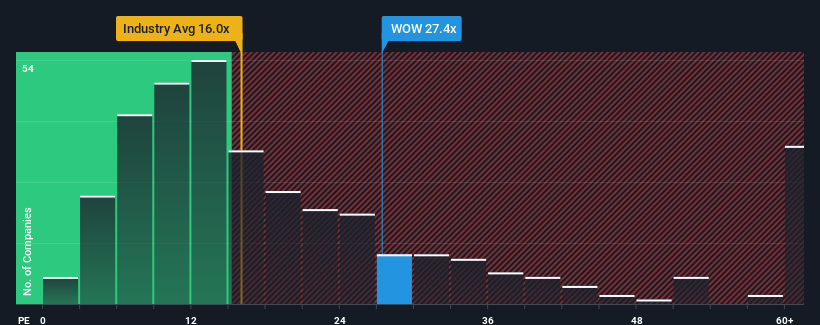- Australia
- /
- Food and Staples Retail
- /
- ASX:WOW
There's Reason For Concern Over Woolworths Group Limited's (ASX:WOW) Price

Woolworths Group Limited's (ASX:WOW) price-to-earnings (or "P/E") ratio of 27.4x might make it look like a sell right now compared to the market in Australia, where around half of the companies have P/E ratios below 18x and even P/E's below 9x are quite common. However, the P/E might be high for a reason and it requires further investigation to determine if it's justified.
Recent times have been pleasing for Woolworths Group as its earnings have risen in spite of the market's earnings going into reverse. It seems that many are expecting the company to continue defying the broader market adversity, which has increased investors’ willingness to pay up for the stock. You'd really hope so, otherwise you're paying a pretty hefty price for no particular reason.
View our latest analysis for Woolworths Group

Does Growth Match The High P/E?
There's an inherent assumption that a company should outperform the market for P/E ratios like Woolworths Group's to be considered reasonable.
Taking a look back first, we see that the company managed to grow earnings per share by a handy 5.3% last year. Pleasingly, EPS has also lifted 87% in aggregate from three years ago, partly thanks to the last 12 months of growth. So we can start by confirming that the company has done a great job of growing earnings over that time.
Looking ahead now, EPS is anticipated to climb by 8.7% per annum during the coming three years according to the analysts following the company. With the market predicted to deliver 18% growth per year, the company is positioned for a weaker earnings result.
In light of this, it's alarming that Woolworths Group's P/E sits above the majority of other companies. Apparently many investors in the company are way more bullish than analysts indicate and aren't willing to let go of their stock at any price. There's a good chance these shareholders are setting themselves up for future disappointment if the P/E falls to levels more in line with the growth outlook.
The Key Takeaway
Using the price-to-earnings ratio alone to determine if you should sell your stock isn't sensible, however it can be a practical guide to the company's future prospects.
We've established that Woolworths Group currently trades on a much higher than expected P/E since its forecast growth is lower than the wider market. Right now we are increasingly uncomfortable with the high P/E as the predicted future earnings aren't likely to support such positive sentiment for long. This places shareholders' investments at significant risk and potential investors in danger of paying an excessive premium.
Before you settle on your opinion, we've discovered 1 warning sign for Woolworths Group that you should be aware of.
Of course, you might also be able to find a better stock than Woolworths Group. So you may wish to see this free collection of other companies that have reasonable P/E ratios and have grown earnings strongly.
Valuation is complex, but we're here to simplify it.
Discover if Woolworths Group might be undervalued or overvalued with our detailed analysis, featuring fair value estimates, potential risks, dividends, insider trades, and its financial condition.
Access Free AnalysisHave feedback on this article? Concerned about the content? Get in touch with us directly. Alternatively, email editorial-team (at) simplywallst.com.
This article by Simply Wall St is general in nature. We provide commentary based on historical data and analyst forecasts only using an unbiased methodology and our articles are not intended to be financial advice. It does not constitute a recommendation to buy or sell any stock, and does not take account of your objectives, or your financial situation. We aim to bring you long-term focused analysis driven by fundamental data. Note that our analysis may not factor in the latest price-sensitive company announcements or qualitative material. Simply Wall St has no position in any stocks mentioned.
About ASX:WOW
Reasonable growth potential slight.

